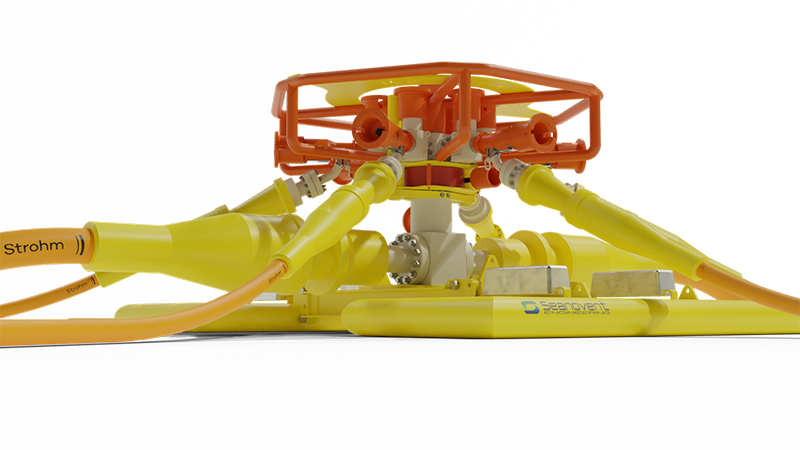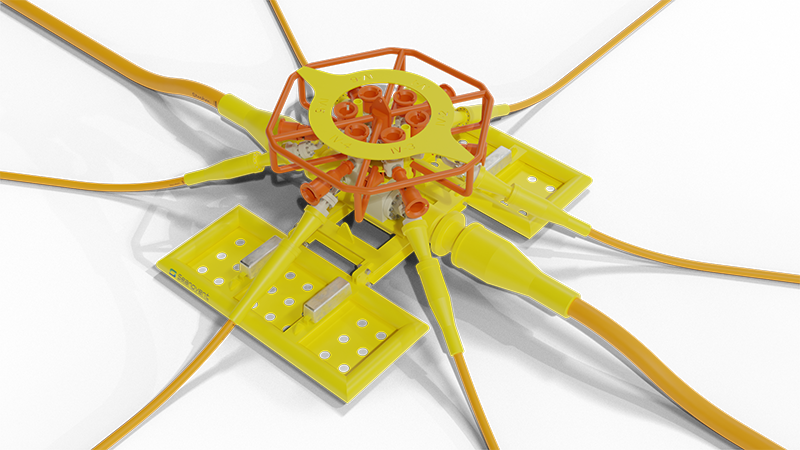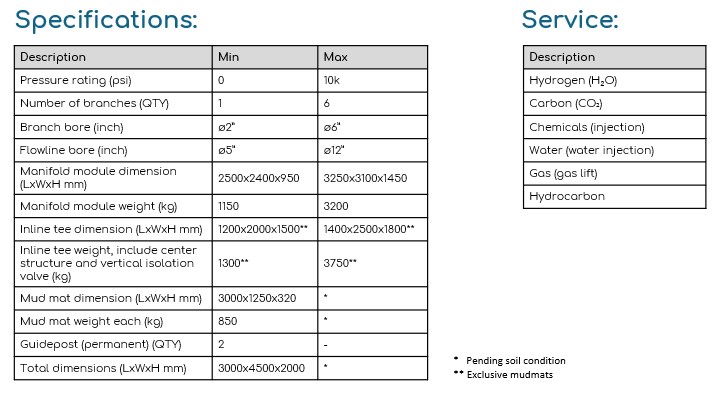Single Service Inline Manifold System (S-SIM)
A subsea compact inline manifold system for gas and fluid distribution based on light weight, reduced loading and spoolable Thermoplastic Composite Pipe (TCP).
A patent pending building block system that can be configured to meet specific requirements to enable limited engineering, high flexibility and short execution period.
The system is easy to scale, allowing for use on both small and large developments.
A lightweight compact system designed for inline installation.

Advantages: A product with extreme low complexity, re-using technology from the subsea hydrocarbon industry in a new configuration, ensure a cost-effective and reliable product at a high readiness level with limited qualification testing needed. Easily customized to meet most field architecture requirements and enable building of a project-specific configuration based on standard components. Installed together with the flowline, with or without the retrievable manifold mounted.

Flexibility: The S-SIM can be configured both as an inline- and as an end-manifold system. The standard manifold design is a 6-way block that can be populated with 1 to 6 valves and connection assemblies. A vertical valve can be added on top of the inline block to allow the manifold to be installed and retrieved without interfering the flow to or from other locations.


Inline installation: The two mud mats on each side of the center structure can either be hinged or disassembled during transport and/or installation. The flowlines to be connected to the inline block in advance of deployment. An A-frame to be connected to a vessel crane or a buoyancy block reducing tension in flowline to ensure correct orientation during installation from vessel to the seabed. A cap or other types of protection caps can be installed in case the manifold module is installed separately.
Inline installation: The two mud mats on each side of the center structure can either be hinged or disassembled during transport and/or installation. The flowlines to be connected to the inline block in advance of deployment. An A-frame to be connected to a vessel crane or a buoyancy block reducing tension in flowline to ensure correct orientation during installation from vessel to the seabed. A cap or other types of protection caps can be installed in case the manifold module is installed separately.
Manifold installation: The manifold module is guided in place by two guideposts ensuring alignment between the up- and down-facing hub. The manifold module is secured by an integrated clamp connector.
Manifold installation: The manifold module is guided in place by two guideposts ensuring alignment between the up- and down-facing hub. The manifold module is secured by an integrated clamp connector.
Branch connection: A standard work ROV with an orientation tool to be used to connect the lightweight TCP to the manifold module
Branch connection: A standard work ROV with an orientation tool to be used to connect the lightweight TCP to the manifold module
Operation: All branch valve operation to be done directly on the top by work ROV.
Optional operation: with remote valve operation by electrical actuator via control cable from adjacent source.
Operation: All branch valve operation to be done directly on the top by work ROV.
Optional operation: with remote valve operation by electrical actuator via control cable from adjacent source.
Protection: A stand-alone protection cover can be installed to protect against dropped object and/or fishing gears.
Protection: A stand-alone protection cover can be installed to protect against dropped object and/or fishing gears.
Product development supported by Innovation Norway.
S-SIM is a world-wide patented system and property of Seanovent Engineering AS.
Other company, products and service names are the properties of their respective owners.
Product development supported by Innovation Norway.
S-SIM is a world-wide patented system and property of Seanovent Engineering AS.
Other company, products and service names are the properties of their respective owners.
